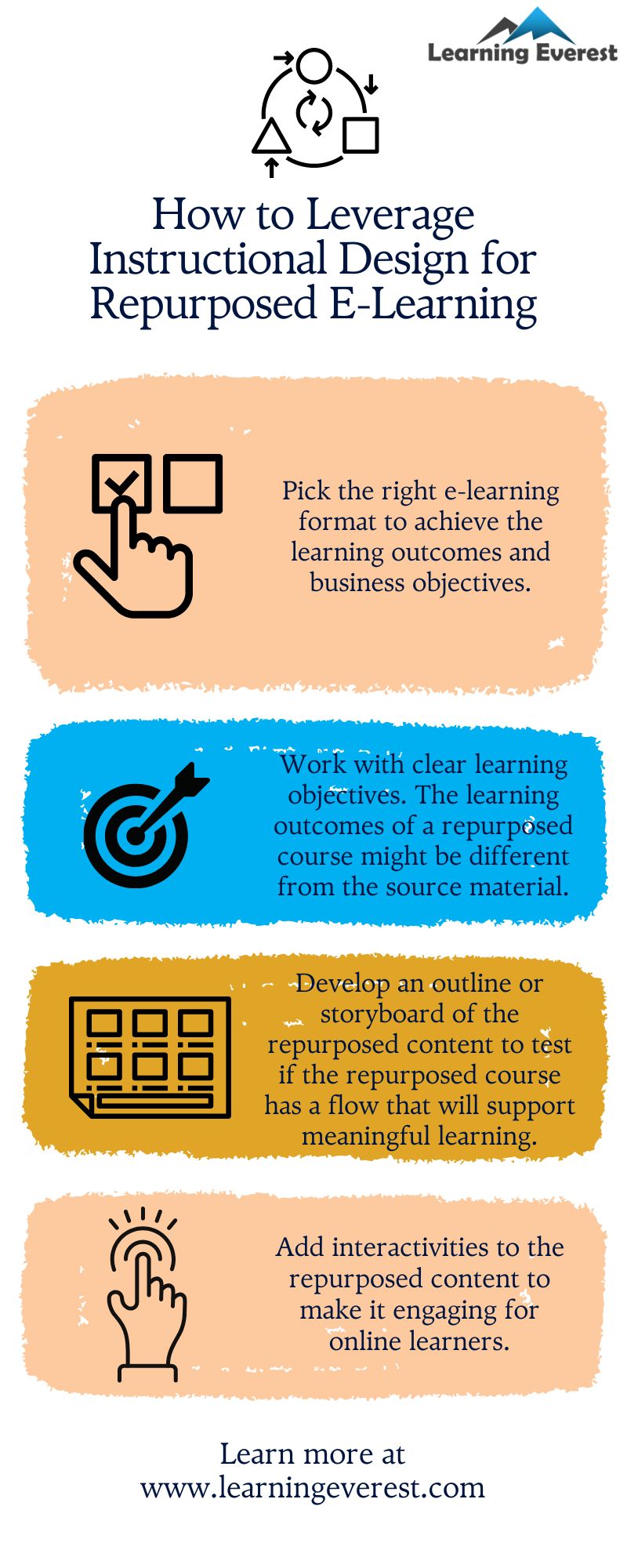Repurposed training content refers to learning materials that have been reused and transformed into a different format than the original. When content is turned into e-learning, it becomes repurposed e-learning. While repurposing involves reuse, it still requires planning and strategy, and the best way to plan how learning materials should be developed is through instructional design. This article will walk you through some of the processes involved in instructional design for repurposed e-learning.
Why is There a Need for Repurposed E-Learning?
Before understanding how training content is repurposed, let us understand why it is repurposed.
Developing new learning resources is not always necessary or efficient. Organizations tend to have treasure troves of existing knowledge that they can put to use. Some reasons behind repurposing learning content are:
- The company has budget constraints
- The company has time constraints
- The company simply wishes to repackage existing content into more formats for broader access
- Past training content has produced measurable and significant results and developing new content would be redundant
- The workforce’s learning preferences have shifted
Kinds of Repurposed E-Learning
Repurposed e-learning can be classified in two ways. One way of classification is the scale and scope of repurposed content:
- Large Scale Transformation – large scale transformation adapts the entire content from one medium to another. For example, turning a PowerPoint-aided instructor-led program into an e-learning course, or an existing eLearning content to highly engaging eLearning content.
- Reuse of Individual Shared Content – this type of repurposing is small-scale and mostly refers to the direct reuse of assets such as logos, diagrams, assessment questions, etc. For example, reusing a uniform company template for all e-learning courses.
Another way to classify e-learning is based on whether the information is being clubbed or chunked:
- Clubbing Information Together – in this form of repurposing, brief training content is compiled to form a longer course or module.
- Breaking up Information into Smaller Chunks – here, parts of longer training programs that can be consumed individually are taken and turned into short programs such as microlearning and nanolearning.
Seeing the different routes repurposed e-learning can take, instructional designing. becomes crucial in the process. This is why the expertise of an instructional designer (ID) is an essential prerequisite in such undertakings.
Using Instructional Design for Repurposed E-Learning
Instructional design processes can come in handy when developing repurposed e-learning content. Here are some tips to repurpose eLearning content:
- Picking the Right Approach – IDs are well-versed in the different forms e-learning can take. They also understand the functions each approach serves. Thus, they can help you identify the possible options you have for repurposing e-learning based on the nature of your content and your business and learning objectives.
- Establishing Learning Objectives – While the learning objectives of repurposed content might seem obvious at first, it is very likely that they won’t be. Learners engage with e-learning in a different manner as compared to non-virtual learning. Additionally, the chunking and clubbing of information will change the learning outcomes drastically. IDs understand that reusing learning materials does not mean offering the same kind of learning and they will help you reframe learning objectives for greater accuracy.
- Developing an Outline or Storyboard for the Repurposed Versions of Courses – Content cannot be repurposed randomly even if the subject matter remains the same. To echo the previous point, the learning experience on a digital platform is distinct from traditional in-person learning. Thus, different presentation formats will need to be tested first and the learning content will need to be organized in a way that flows and makes sense. Thus, developing an outline or creating a storyboard before building the final product is vital. IDs are experts at outlining and storyboarding and will build a sample of the finished product to test if the desired vision is being executed properly and effectively.
- Making the Repurposed Content Interactive – The base content used for repurposing is rarely perfectly compatible with e-learning. Interactivity is one of the most significant areas where this incompatibility becomes apparent and require efforts to convert the content to highly engaging training. For online learning to be effective, interactivity is a must. Passively offering the information to learners will fail to hold their attention, making the training a waste of both parties’ time and resources. IDs can transform even the most dry content into an interactive and enjoyable experience for learners. Without interactivities, the repurposed content will lose its impact. Thus, making it another area where the abilities of a dedicated instructional designer will come in extra handy.
Infographic
Conclusion
Repurposed e-learning has many benefits. It saves businesses time and money while also ensuring that the content being offered is meaningful and worthwhile. However, as straightforward as it may seem, repurposing e-learning is not a simple task. It is more than migrating content from one format to another. The process requires prior planning and strategizing in order to retain learning effectiveness. Thus, instructional design is absolutely necessary for the process.






